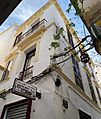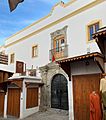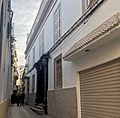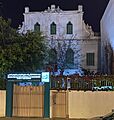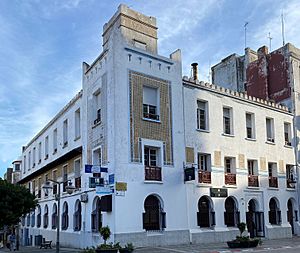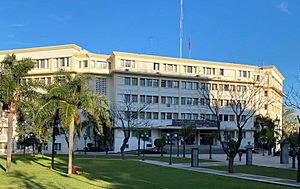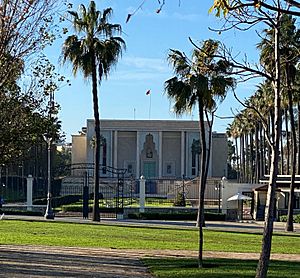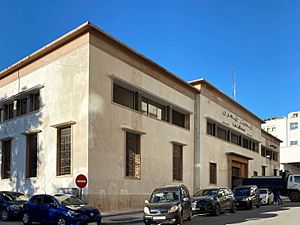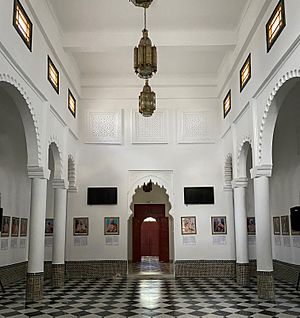Tangier International Zone facts for kids
Quick facts for kids
Tangier International Zone
|
|||||||||
|---|---|---|---|---|---|---|---|---|---|
| 1925–1940 1945–1956 |
|||||||||
|
Flag
|
|||||||||
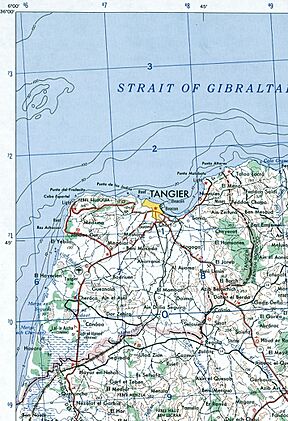
Map of the Tangier International Zone, with boundary
|
|||||||||
| Status | International Zone | ||||||||
| Capital | Tangier | ||||||||
| Common languages | French, Spanish, Arabic, Darija, English, Portuguese, Dutch, Haketia | ||||||||
| Official languages | French, Spanish, Arabic | ||||||||
| Religion | Islam, Christianity, Judaism | ||||||||
| History | |||||||||
|
• Established
|
1 June 1925 | ||||||||
|
• Spanish occupation
|
14 June 1940 – 11 October 1945 | ||||||||
|
• Disestablished
|
29 October 1956 | ||||||||
| Area | |||||||||
|
• Total
|
382 km2 (147 sq mi) | ||||||||
| Currency | Moroccan franc | ||||||||
|
|||||||||
| Today part of | Morocco | ||||||||
The Tangier International Zone was a special area around the city of Tangier in Morocco. It was about 382 square kilometers (147 square miles) in size. This zone existed from 1925 until 1956, when Tangier became fully part of independent Morocco again.
During World War II, Spain occupied Tangier for a few years, from 1940 to 1945. The zone was unique because it was governed by several European countries, the United States, and the Sultan of Morocco. This special status made Tangier an important place for Moroccan Nationalists who were working for Morocco's independence. They used it to connect with people from other countries and organize meetings.
Contents
How Tangier Became an International Zone
Early International Connections
For a long time, Tangier was a military town. It was an important fort for the Moroccan Sultanate near the Strait of Gibraltar. In 1777, the Sultan decided Tangier would be the main place for Morocco to deal with European businesses. This led many European countries to open consulates (offices for their representatives) in the city.
By 1830, countries like Denmark, France, Spain, the United Kingdom, and the United States all had consulates in Tangier. In 1851, the Sultan appointed a special representative, called the Naib, to work with these foreign powers.
Special Rules for Foreigners
Moroccan law at the time applied only to Muslims and Jews. So, special agreements were made for foreign representatives. These agreements, called "capitulations," gave foreigners different legal treatment. For example, the United Kingdom started a postal service in Tangier in 1857, and other countries like France and Spain followed.
Foreign countries in Tangier also started working together on projects. As early as 1792, they cooperated on health and quarantine issues. In 1840, the Sultan ordered them to create a Sanitary Council to manage public health. They also worked together to build the Cape Spartel lighthouse, which opened in 1864.
In 1879, the Sultan created Tangier's Hygiene Commission. This group acted like a city council, with members chosen by foreign diplomats, the Sultan, and local leaders. It helped manage the city, including road work. In 1904, a secret agreement between France and Spain recognized Tangier's special status, hinting at its future as an international zone.
Algeciras Conference and Treaties
The Algeciras Conference in 1906 created the State Bank of Morocco in Tangier. It also set up new groups to manage the city, like an Office of Public Works. The conference also led to a police force with French and Spanish parts.
In 1912, the Treaty of Fes made Morocco a French protectorate. This brought up the question of Tangier's status again. Both France and Spain wanted control, but the United Kingdom wanted Tangier to be neutral to protect its power in the Strait of Gibraltar. Later that year, a treaty between France and Spain said Tangier would have a special status and defined its borders.
A committee met in Madrid in 1913 to discuss this, but World War I started before they could agree. So, Tangier continued to be governed by a mix of old and new groups, including a Sultan-appointed governor, foreign courts, and various committees.
History of the International Zone
Creating the Zone: 1923 and 1928 Agreements

After World War I, talks began again. In December 1923, France, Spain, and the UK signed the Paris Convention. This agreement made Tangier a neutral zone, meaning it would not have any military presence. It also made Tangier a place with very low taxes, which meant no taxes on imported or exported goods, no currency controls, and no income taxes. This encouraged businesses to set up there.
The Tangier International Zone officially started on June 1, 1925. New international groups took over the jobs of the older local councils. Other countries like Belgium, Sweden, the Netherlands, and Portugal later joined the agreement. Italy did not join at first because it felt it was not treated as an equal power. The United States also chose to stay out at this time.
Italy eventually joined the international framework in 1928, after a new agreement was signed in Paris. This new agreement also led to the final closing of Tangier's older local institutions.
Spanish Occupation During World War II
Spanish troops took control of Tangier on June 14, 1940, the same day Paris fell to the Germans. Spain said this was a temporary measure to protect Tangier's neutrality. The main governing bodies of the Zone were shut down. This caused a disagreement between Britain and Spain. Tangier was effectively added to the Spanish Protectorate of Morocco in November 1940. In 1944, Spain expelled all German diplomats from the Zone.
Returning to International Control After the War
After the war, a meeting in Paris in August 1945 decided to bring back the international control of Tangier. Spain was not invited to this meeting. The agreement was signed on August 31, 1945, and it officially started on October 11, 1945. On this date, the Spanish government pulled out its military and handed the territory back to the international groups.
From then on, the U.S. joined the Committee of Control and appointed a judge. The Soviet Union soon lost interest in Tangier, which allowed Spain to rejoin the international framework, though without administrative roles. Italy also got its former position back.
A new status for Tangier was agreed upon in November 1952. This updated how the Zone was managed and reformed its courts.
Ending the International Zone
When the French protectorate in Morocco ended in March 1956, and the Spanish one in April 1956, the international status of Tangier also came to an end. In July 1956, a temporary agreement was signed, and the position of Administrator was replaced by a Moroccan governor. The Tangier police force also came under Moroccan control.
A conference in October 1956 officially returned Tangier to full Moroccan control. This took effect immediately. The international institutions continued to operate only until the end of 1956 for practical reasons.
In August 1957, the Moroccan King, Mohammed V, granted a special charter to help Tangier transition and keep some of its tax benefits for a while. However, this special status finally ended in April 1960, marking the complete end of the Tangier International Zone.
How Tangier Was Governed
The way Tangier was governed was very special and sometimes confusing. It was often changed and seen as temporary. Different countries were always trying to gain more influence, which sometimes made things less efficient. The government had five main parts:
- The Committee of Control (an oversight group).
- The Administrator (the main executive leader).
- The Legislative Assembly (the law-making body).
- The Mixed Courts (the judicial system).
- The Mendoub (the Sultan's representative, who handled matters for Muslim and Jewish communities).
Committee of Control
This committee was made up of the Consuls (representatives) from the countries involved. Its leader changed every year. The committee could reject laws passed by the Legislative Assembly.
Administrator
The Administrator was in charge of running the Zone, except for matters concerning Muslim and Jewish communities, which were handled by the Mendoub. The Sultan formally appointed the Administrator, based on suggestions from the Committee of Control.
Before 1940, all Administrators were French. They had two deputies, one French and one British. After 1945, the role was held by people from smaller nations, like Portugal, the Netherlands, and Belgium. The Administrator also appointed the head of the city police.
Legislative Assembly
This was the Zone's law-making body. The Mendoub led it, and the Committee of Control oversaw it. The assembly had members from different countries: 4 French, 4 Spanish, 3 British, 2 Italians (later 3, then 1), 1 American (later 3), 1 Belgian, 1 Dutch, 1 Portuguese, 6 Muslims, and 3 Jews. The Mendoub chose the Muslim and Jewish members.
After World War II, a new building was built for the Legislative Assembly in Tangier.
Mixed Courts / International Justice
The Mixed Courts handled legal cases for residents from the participating countries. Initially, these courts had four judges (two British, one French, one Spanish). Later, more judges were added from other countries. These courts were seen as a unique experiment because of their international setup. The laws they used were a mix of French and Spanish rules, and the official languages were French and Spanish.
The Mixed Courts continued to operate even during the Spanish occupation in World War II. In 1952, they were renamed the International Jurisdiction and had even more judges from various countries. However, they still had some problems, like not having enough Muslim Moroccan representation.
The Mixed Courts were just one part of Tangier's complex legal system. Cases only involving Muslim and Jewish communities were handled by their own courts under the Mendoub. American citizens remained under the legal system of the U.S. consulate.
The Mixed Courts moved to a new building in 1937. After Morocco gained independence, this building became the city courthouse.
Mendoub
The Mendoub was the Sultan's representative and had direct authority over the Muslim and Jewish communities. He also led the Legislative Assembly, though he did not have a vote. He was responsible for putting the assembly's laws into action, but only after the Committee of Control approved them. His office was in a building called the Mendoubia.
Economy and Culture
At first, the creation of the International Zone hurt Tangier's economy. The Spanish protectorate authorities made it difficult to trade with Tangier, so the city lost many of its traditional trading partners.
However, over time, Tangier's special status helped its economy recover. It became known for being a place of tolerance and diversity. People from different cultures and religions lived there. It also became a popular place for tourists, writers, and artists. Many people found it a place where they could live more freely.
Tangier also became a major financial center with very low taxes. By 1950, there were 85 banks in Tangier, a big increase from only 4 in 1900. This was because there were almost no rules for banks, making it very easy to do business there without much oversight.
Before World War I, Tangier had about 40,000 people: half Muslim, a quarter Jewish, and a quarter European Christians. By 1956, the population had grown to about 40,000 Muslims, 31,000 Christians, and 15,000 Jews.
What Happened After Independence
After Morocco became independent, the buildings that housed the international zone's institutions were used for new purposes. The Administration building became the local government office. The International Jurisdiction building became Tangier's main courthouse. The Legislative Assembly building became the Marshan Palace, Tangier, used by the Moroccan monarchy for ceremonies. The Mendoubia became a commercial court and later a museum.
See also
 In Spanish: Zona Internacional de Tánger para niños
In Spanish: Zona Internacional de Tánger para niños





